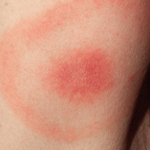Little Bug, Big Consequences: Understanding Lyme Disease
Published on
Health Tip of the WeekPublished on
Health Tip of the Week Warm weather is back, making it a great time for kids to enjoy nature. A hike in the woods or exploring creeks can be a wonderful family activity at a time when other typical outings may still be limited because of the ongoing COVID-19 pandemic. However, along with good weather, spring brings out those pesky — and potentially dangerous — Lyme disease-carrying ticks.
Warm weather is back, making it a great time for kids to enjoy nature. A hike in the woods or exploring creeks can be a wonderful family activity at a time when other typical outings may still be limited because of the ongoing COVID-19 pandemic. However, along with good weather, spring brings out those pesky — and potentially dangerous — Lyme disease-carrying ticks.
So, while communing with nature is great for kids, it’s important for parents to understand Lyme disease, its symptoms and how to prevent it.
At each stage of its life — as larvae, nymphs and adults — a tick requires a blood meal. Ticks normally feed on animals, ground-feeding birds or reptiles. Humans are a back-up food choice.
If you and your children live near or have recently visited an area where ticks are common, you should call your pediatrician immediately if your child has any of these symptoms:
 Bull's-eye rash caused by Lyme disease
Symptoms can appear as long as 30 days after a tick bite, but usually show up within three to seven days. All of these symptoms are suggestive of early Lyme disease, which occurs within a month after a bite from an infected tick.
Bull's-eye rash caused by Lyme disease
Symptoms can appear as long as 30 days after a tick bite, but usually show up within three to seven days. All of these symptoms are suggestive of early Lyme disease, which occurs within a month after a bite from an infected tick.
The good news: Early Lyme disease is easy to diagnose and responds to treatment with antibiotics. However, some patients never experience any symptoms of early Lyme disease and may present a few weeks or months after a tick bite with a variety of symptoms that include meningitis or facial muscle palsy, multiple rashes or an irregular heartbeat. Late Lyme disease can present months or possibly even years after a bite from an infected tick. The most common form of late Lyme disease is arthritis. The knee joints are most commonly involved.
The best route is to avoid a tick bite altogether by taking precautions.
Here are some steps to take to prevent tick bites:
So, you found a tick on your child. Here’s how to remove it:
After you have removed the tick, call your pediatrician to see if your child should be evaluated. If your child develops a rash or flu-like symptoms, take them to the doctor so treatment can begin as soon as possible.
Reviewed by: Sanjeev Swami, MD, Director of the Outpatient Infectious Diseases Clinic in the Division of Infectious Diseases at Children's Hospital of Philadelphia
Categories: Weekly Health Tips, Lyme Disease